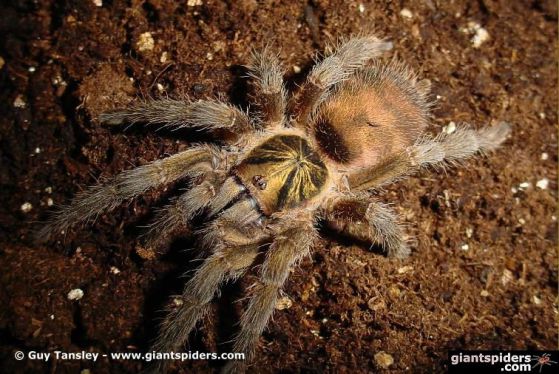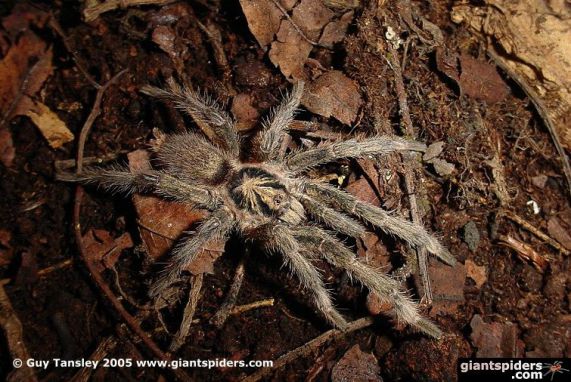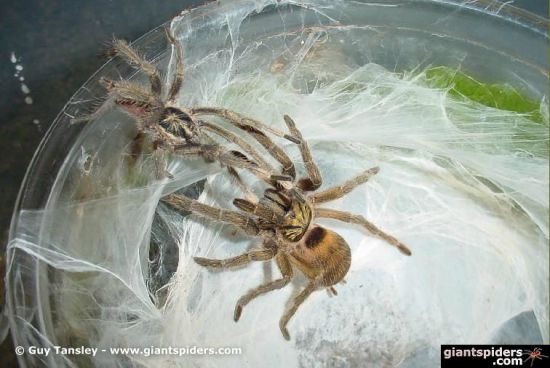
Captive care of Holothele incei
Guy Tansley
Holothele incei (F. O. P.-Cambridge, 1898) is a small species originating from scrub and tropical rainforest areas of Trinidad where it is relatively common but is nevertheless a fascinating species to rear. Commonly called the Trinidad olive, I have had specimens in my collection for nearly 10 years and have been lucky enough to breed them on several occasions. Similar in colouration to another Trinidad species, P. cambridgei, H. incei is clothed in olive green and brown hairs and the carapace takes on a beautiful golden tinge as the females mature. The abdomen in similarly patterned with chevrons. Males are around half the size of the female when mature and lack the chevron pattern on the abdomen. The carapace takes on a silvery appearance and the legs are grey/brown with the tarsi almost black. Surprisingly large as spiderlings, they have a voracious appetite from day one and grow relatively quickly, attacking prey from the safety of their burrow.
On average, females only reach around 60mm in legspan and they are copious web-spinners, filling their containers with thick silken tubes, tunnelling through the substrate. Housing is a simple affair and any medium to large size container will suffice. A deep substrate (peat or peat/vermiculite mix) will allow the spider to burrow but it will do equally well with less, constructing its retreat around the sides of the container. Kept at average temperatures of around 75oF with 65-70% RH, I have found them easy to rear with females reaching around 8 years in captivity.
Easily bred in captivity, courtship for this species is long and involves much leg drumming from the responsive female. Fresh males are under no threat but it is noted that the female may kill the male instantly on a second introduction. Eggsac’s are laid some three weeks after mating and approximately four weeks later the fully formed spiderlings emerge, totalling around 100. Well fed specimens occasionally produce a second eggsac from the same pairing but this is usually smaller than the first and contains less young.
The following notes are from my diary on H. incei over a 18 month period:
15/10/99: Laid infertile egg sac.
21/10/99: Mated (male from same eggsac). Calm pairing with multiple palp insertions over a long period (10 minutes). The male shows no fear towards the female and began courtship on introduction. Female responded eagerly and emerged from her burrow to mate.
01/12/99: Eggsac produced. A deep burrow was excavated and the spider sealed itself inside. The mobile eggsac measures approx. 15mm in diameter and can be clearly seen through the silk inside the container.
01/02/00: Spiderlings separated (77 in total).
22/02/00: Mated (same male as previous), courtship and pairing similar to the first time.
25/03/01: Moulted.
06/07/01: Mated again. Long courtship, brief palp insertion and female attacked male but he escaped unharmed.
08/07/01: Killed second male on introduction. This time, instead of beginning to court the female on introduction, the male began to groom himself on the edges of the females’ web. Sensing his presence, the female moved slowly towards his position and attacked almost immediately.
25/07/01: Laid eggsac.
16/08/01: Eggs hatched. Found a spiderling with double abdomen (this specimen managed to go through its first moult successfully but died soon after). Separated spiderlings - 108 in total.
01/01/02: Moulted.
30/04/02: Mated.
03/08/02: Moulted.
At the time of writing I have one female currently on an eggsac (originating from the breeding in February 1999) and hopefully spiderlings will be available soon.
This article first appeared in ARACHNOCULTURE Magazine, 1 (1): 4-7 (2005).


